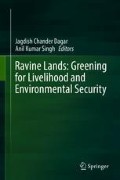Abstract
Ravine lands, the most severe form of water erosion leading to formation of badlands, occupy about 4 Mha (1.22%) of land area in India. These lands have strongly impacted economic, social, cultural, and environmental features of the region. This article describes the cause-effect relationship, suggests some preventive and control measures, and assesses the potential of soil carbon sequestration. Formation of ravine lands is triggered by tectonic activity, climate change, or drastic change in land use. In India, ravines are formed in the semiarid climate with short (3-month) monsoonal rains and a long dry season. On the basis of morphological features (depth, width, density, etc.), ravines can be categorized into shallow, medium, and deep. An effective restoration/rehabilitation necessitates characterization of ravines using satellite imagery and other remote sensing techniques validated by ground-truthing. For an effective control measure, runoff into the ravine land must be diverted using techniques of safe disposal and a perennial vegetation cover established. Deep ravines must also be afforested to stabilize further growth. Medium and shallow ravines can be bulldozed for agricultural forestry land use. Carbon sequestration in soil and biomass, with a technical potential of 2.6–5.3 TgC year−1, can generate another income stream for farmers (US$300–640 million year−1) and promote the adoption of best management practices for both preventative and control measures.
Access this chapter
Tax calculation will be finalised at checkout
Purchases are for personal use only
References
Avni Y (2005) Gully incision as a key factor in desertification in an arid environment, the Negev highlands, Israel. Catena 1000:83–90
Bradshaw AD, Chadwick MJ (1980) The restoration of land: the ecology and reclamation of derelict and degraded land. Blackwell Scientific Publications, Oxford, p 317
Bryan R, Yair A (1982) Perspectives on studies of badland geomorphology. In: Bryan R, Yair A (eds) Badland geomorphology and piping. Geo Books, Norwich, pp 1–12
Chatterjee RS, Saha SK, Kumar S, Mathew S, Lakhera RC, Dadhwal VK (2009) Interferometric SAR for characterization of ravines as a function of their destiny, depth and surface cover. ISPRS J Photogram Remote Sens 64(5):472–481
Dayal R (1975) Halt the march of ravines. Intensiv Agric 13(4):20
Dwivedi RS, Ramana KV (2003) The delineation or reclamative groups of ravines in the Indo-Gangetic alluvial plains using IRS-1D LISS-III data. Int J Remote Sens 24(22):4347–4355
Faulkner H (2008) Connectivity as a crucial determinant of badland morphology and evolution. Geomorphology 100:91–103
Gallart F, Marignani M, Péres-Gallego N, Santi E, Maccherini S (2013) Thirty years of studies on badlands, from physical to vegetational approaches – a succinct review. Catena 106:4–11
Gupta RK, Prajapati MC (1983) Reclamation and use of ravine lands. Desert Resour Tech (Jodhpur) 1:221–262
Haigh MJ (1984) Ravine erosion and reclamation in India. Geoforum 15(4):543–531
Harvey AM (2002) Effective timescales of coupling within fluvial systems. Geomorphology 44:175–201
Joshi VU (2014) Landscapes and landforms of India. In: Kale VS (ed) World geomorphological landscapes. Springer, New York, pp 143–149
Joshi VU, Nagare VB (2013) Badland formation along the Pravara River, Western Deccan, India. Can neotectonics be the cause? Z Geomorphol 57(3):349–370
Kandrika S, Dwivedi RS (2013) Reclamative grouping of ravines using Cartosat-1 PAN stereo data. J In Soc Remote Sens 41(3):731–737
Lal R (2014) Societal value of soil carbon. J Soil Water Conserv 69:186A–192A
Lal R (2015) A system approach to conservation agriculture. J Soil Water Conserv 70(4):82A–88A
Larue JP (2005) The status of ravine-like incisions in the dry valleys of the Pays de Thelle (Paris basin, France). Geomorphology 68:242–256
Mather AE, Stokes M, Griffiths JS (2002) Quaternary landscape evolution: a framework for understanding contemporary erosion, southeast Spain. Land Degrad Dev 13:89–109
Morris CG (1992) Dictionary of information, science and technology. Academic Press, New York
Mudgal MK (2005) Socio-economic impact of ravine lands- a case study of River Chambal basin of state of Madhya Pradesh, India. Geophy Res Abstracts 7:00529
Pani (2016) Controlling gully erosion: an analysis of land reclamation processes in Chambal, India. Dev Pract 26(8):1047–1059
Pani P, Mohapatra SN (2001) Delineation and monitoring of gullied and ravine lands in a part of lower Chambal Valley, India using remote sensing and GIS. Proc ACRS Singapore 1:671–675
Parsons AJ, Abraham AD (2009) Geomorphology of desert environments, Second edn. Springer Science and Business Media, Berlin, p 831
Rai R, Maurya DM, Chamyal LS (1999) Tectonic control on distribution and evolution of ravines in the lower Mahi valley, Gujrat. J Geological Soc India. 53:669–6674
Sharma HS (1976) Morphology of ravines of the Morel basin, Rajsthan, India. Int Geogr 1:219–233
Sharma HS (1980) Ravine erosion in India. Concept, New Delhi
Singh A, Dayal R (1975) Development of water resources in ravine utilization-a case study. Soil Conservation Digest 3(1):26–30
Singh AK, Kala S, Dubey SK, Pande VC, Rao BK, Sharma KK, Mahapatra KP (2015) Technology for rehabilitation of Yamuna ravines- cost effective practices to conserve natural resources through bamboo plantation. Curr Sci 108:1527–1533
Singh JS, Singh KP, Jha AK (1996) Final Technical Report. Submitted to the Ministry of Coal, Government of India, p 116
Tejwani KG, Gupta SK, Mathur HN (1975) Soil and water conservation research 1956–1971. ICAR, New Delhi
Thomas D (2011) Arid zone geomorphology: process, form, and change in drylands, 3rd edn. Wiley, Hoboken, p 648
Torri S, Bryan R (1997) Micropiping processes and biancana evolution in southeast Tuscany, Italy. Geomorphology 20:219–235
Yadav RC, Bhushan LS (2002) Conservation of gullies in susceptible riparian areas of alluvial soil regions. Land Degrad Dev 13(3):201–219
Author information
Authors and Affiliations
Corresponding author
Editor information
Editors and Affiliations
Rights and permissions
Copyright information
© 2018 Springer Nature Singapore Pte Ltd.
About this chapter
Cite this chapter
Lal, R. (2018). Sequestering Carbon in Ravine-prone and Eroded Landscapes. In: Dagar, J., Singh, A. (eds) Ravine Lands: Greening for Livelihood and Environmental Security. Springer, Singapore. https://doi.org/10.1007/978-981-10-8043-2_20
Download citation
DOI: https://doi.org/10.1007/978-981-10-8043-2_20
Published:
Publisher Name: Springer, Singapore
Print ISBN: 978-981-10-8042-5
Online ISBN: 978-981-10-8043-2
eBook Packages: Biomedical and Life SciencesBiomedical and Life Sciences (R0)

